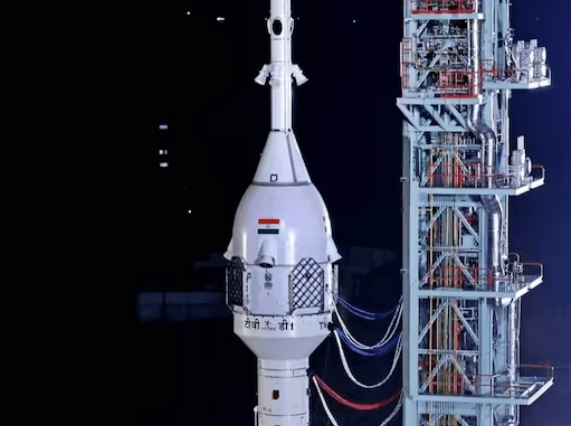Bringing us closer to India’s inaugural Human Space Mission, the Gaganyaan mission, we achieved a significant milestone on October 21, 2023. The first Test Vehicle Flight TV-D1 successfully lifted off from Sriharikota, marking a critical phase in our journey toward space exploration.
On October 21st, the Indian Space Research Organisation (ISRO) achieved a major milestone with the successful inaugural Flight Test Vehicle Abort Mission-1 (TV-D1) of Gaganyaan. This mission not only demonstrated the exceptional performance of the Crew Escape System but also its safe touchdown in the Bay of Bengal. The ISRO continues to push the boundaries of space exploration and engineering excellence.
About GaganYaan
The Gaganyaan project aims to showcase India’s human spaceflight prowess. It involves the launch of a crew of three members into a 400 km orbit for a three-day mission, followed by a safe return to Earth, gracefully touching down in the waters of the Bay of Bengal.

The project is accomplished through an optimal strategy that takes into account the expertise within our organization, the experience of the Indian industry, the intellectual capabilities of Indian academia and research institutions, as well as cutting-edge technologies available internationally. Essential developments for the Gaganyaan mission include the creation of critical technologies such as a human-rated launch vehicle for safely transporting crew to space, a Life Support System to provide a crew-friendly environment in space, provisions for crew emergency escape, and the continuous improvement of crew management aspects, including training, recovery, and rehabilitation.
Before undertaking the Human Space Flight mission, several precursor missions are scheduled to demonstrate the Technology Preparedness Levels. These preliminary missions consist of the Integrated AirDrop Test (IADT), Pad Abort Test (PAT), and Test Vehicle (TV) flights. The safety and reliability of all systems will be verified through unmanned missions that precede the manned mission.
Gaganyaan mission launch date
On October 21, 2023, ISRO achieved a milestone in the Gaganyaan program by successfully launching its Test Vehicle – Demonstration (TV-D1), a single-stage liquid propulsion rocket. This test mission, incorporating a crew module, marks a significant step forward as it integrates a nearly complete system for evaluation and validation.
The successful test flight has paved the way for the upcoming qualification tests and uncrewed missions, ultimately culminating in the inaugural Gaganyaan program. This milestone sets the foundation for further advancements and endeavors in the realm of space exploration.
The Vehicle Abort Mission (TV-D1) successfully executed the crew escape system and safely landed the crew module in the sea, approximately 10 km off the eastern coast of Sriharikota, India. The Navy later retrieved the module from the Bay of Bengal. This important campaign aims to ensure the utmost safety of the crew who will embark on the Gaganyaan mission aboard an LVM-3 rocket.
Gaganyaan Mission- First Test Successful
The TV-D1 was originally planned to take off at 8 a.m. on October 21 from the first launch pad of the Satish Dhawan Space Centre in Sriharikota. However, due to adverse weather conditions, the launch was momentarily delayed just 5 seconds before liftoff. Fortunately, it was later rescheduled for 8:45 a.m. and executed successfully.
“This flight simulated an abort condition encountered during the ascent trajectory of the Gaganyaan mission, specifically at a Mach number of 1.2. At an altitude of 17km, the Crew Escape System (CES) successfully separated from the Test Vehicle. Subsequently, the autonomous abort sequence was initiated, beginning with the separation of CES and deployment of a series of parachutes. The sequence concluded with a safe touchdown of the Crew Module (CM) in the Bay of Bengal, approximately 10 km away from the Sriharikota coast.”

The Indian Navy took charge of the recovery operation for the TV-D1 CM upon touchdown. Recovery vessels were strategically positioned in the sea, ready to approach the CM. A team of skilled divers attached a buoy and used a ship crane to safely lift the CM, transporting it to the shore.
The objective of the Gaganyaan Test Mission
The mission aims to demonstrate and evaluate the flight capabilities of the test vehicle, including its subsystems. Additionally, it will assess the performance of the CES, examining the various separation systems and CM characteristics. Furthermore, the mission will showcase the deceleration systems at higher altitudes and successfully recover from them.
The primary goal of the Simplify mission was to evaluate the safety features of the CES in safeguarding the CM during emergency scenarios, enabling ISRO to efficiently abort the mission when necessary.
The primary objective of the Gaganyaan mission is to showcase our capability in launching and safely human beings to Earth’s low Earth orbit. This ambitious mission will involve a crew of three and concludes with their landing in either the Bay of Bengal or the Arabian Sea.
Future of Gaganyaan Mission
In the coming year, an additional unidentified flight will transport the humanoid VyomMitra. Following that, a manned flight is anticipated to occur by 2025.
Technologies for Gaganyaan
Rockets Used: Human-rated LVM3 – HLVM3
The Gaganyaan mission has chosen the reliable and well-proven LVM3 rocket as its launch vehicle. Comprising of solid, liquid, and cryogenic stages, the LVM3 has been extensively re-configured to meet the stringent criteria for human-rated spaceflight. Renamed as the Human Rated LVM3, this advanced launch vehicle has the capability to deploy the Orbital Module into a targeted Low Earth Orbit of 400 km.
HLVM3 features a Crew Escape System (CES) propelled by a set of rapid-acting, high-burn-rate solid motors. This guarantees the safe transport of the Crew Module and its occupants to a secure distance in the event of an emergency, be it at the launch pad or during the ascent phase.
New technologies being developed for Gaganyaan
Ens human safety is of utmost importance in the Gaganyaan mission. To achieve this goal, a comprehensive array of cutting-edge engineering and human-centric technologies is being developed and implemented. By prioritizing the refinement of these systems, we aim to maximize safety and guarantee the success of the mission.

